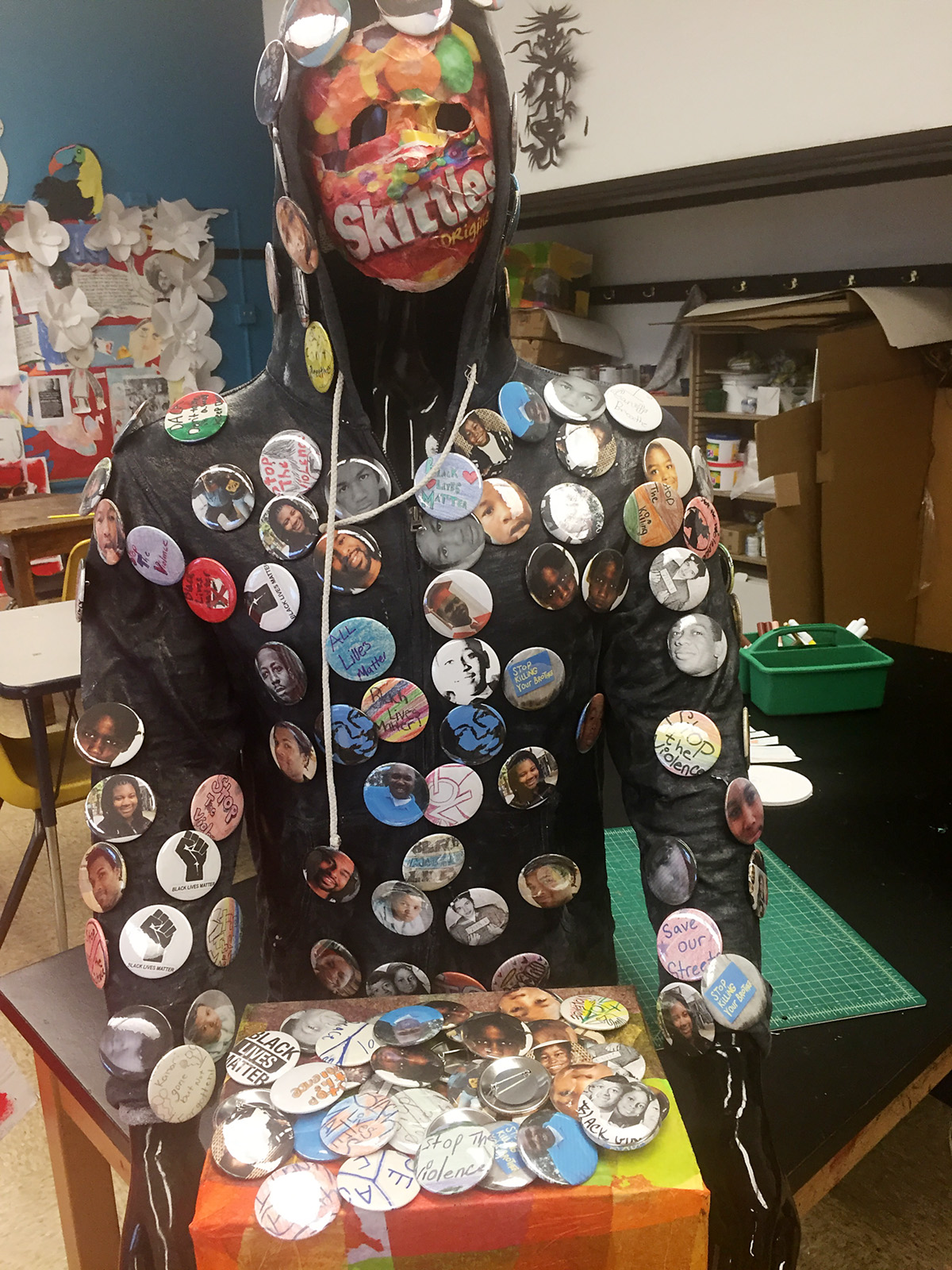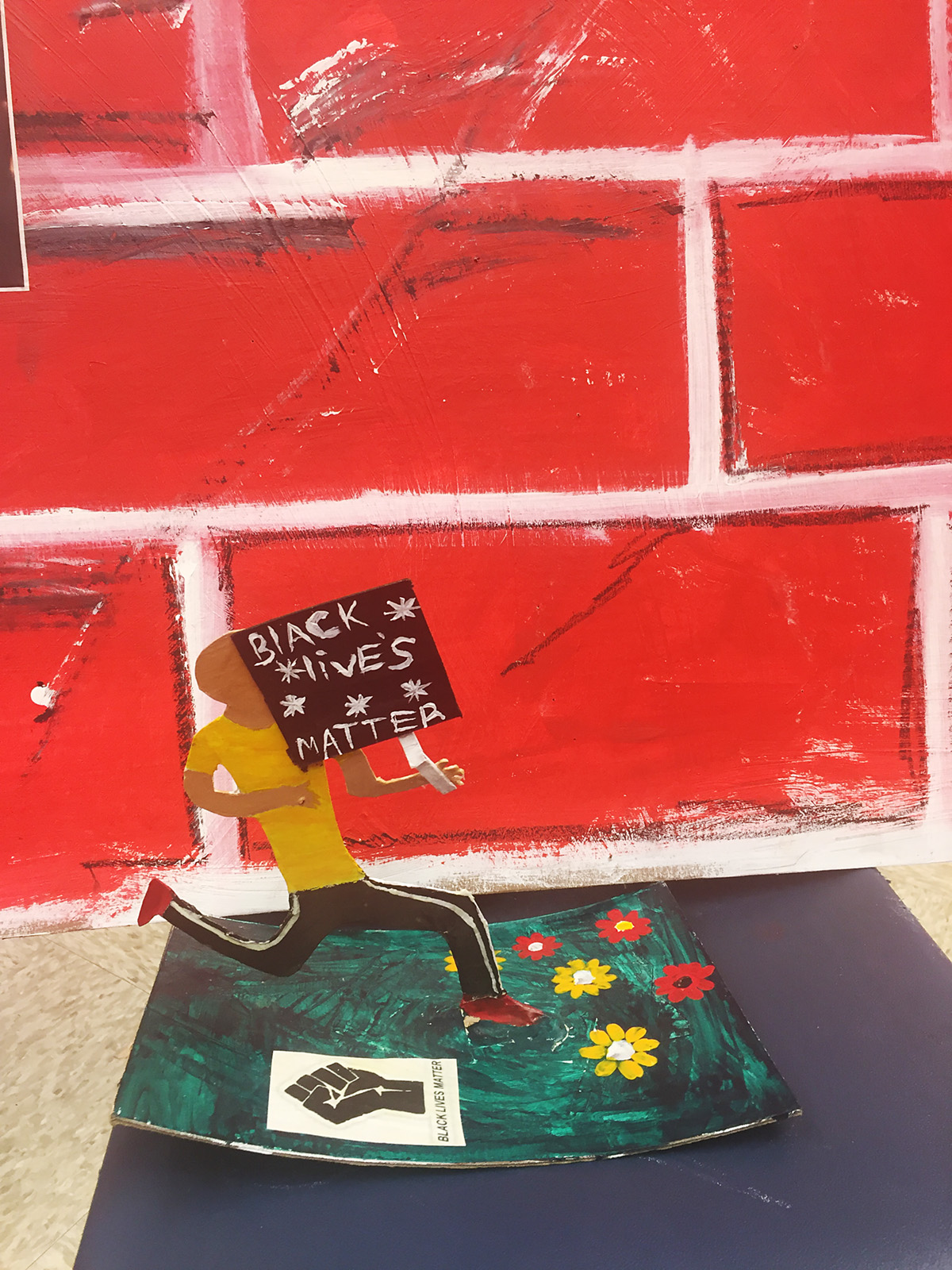From Parks to Kaepernick: Art for Healing and Change
By Darrell Pulliam

Eighth Graders at Henderson Academy engaged in a series of investigations, critical dialogues, and studio projects exploring social issues relevant to their lives while studying public protest and civically-engaged art for social change. Their work lead up to a culminating community event, a Peace March in the Englewood neighborhood.

Goals
- Students will be able to compare and contrast contemporary acts of civil disobedience and historical examples from the civil rights era.
- Students will construct representations of their identities by constructing assemblages and collages.
- Students will be able to use studio arts to convey messages to the community about issues that matter to them.
Guiding Questions
- What is civil disobedience?
- What is socially-engaged art?
- How can art be used to speak up for issues that matter?

Documentation + Assessment Strategies
The work that the students produced was photographed and videotaped, an assemblage of some of the buttons was created to document their work. A Black store mannequin was purchased to represent African American people, and a hoodie was placed over the mannequin to represent the youth and as an iconic representation of Trayvon Martin. A mask was created and covered with the Skittles brand candy package to represent youth and the vulnerability of being young and African American in America.
Learning Activities
STEP 1
Social Activism and Socially-Engaged Art
The teacher introduced the lesson by sharing biographical information about key figures in civil disobedience and socially-engaged art, including such key figures as Colin Kaepernick, discussing why he refused to stand for the American national anthem and asking whether this gesture was a constitutional right. Students discussed past figures of civil disobedience such as Muhammad Ali’s refusal to fight in the Vietnam War and Rosa Parks’s refusal to obey segregation laws. Students had prior knowledge of all key figures through their activities with their social studies instructor. However, in visual art class, we elaborated on the unjust laws and one’s constitutional rights and how one can peacefully protest unjust laws that discriminate against people of color or African descent.
STEP 2
Identifying as a Person of Color
During class discussion, students identified key figures who lost their lives to apparent racist acts, such as Trayvon Martin, Sandra Bland, and Emmett Till. Students identified the lives of the key figures with their own, and compared and contrasted these elements to the past and present demise of people of color through racist acts.
Building on examples of civic leaders of color, the teacher led an interactive discussion about identifying oneself as a person of color in the United States today. What issues affect the everyday lives of Black and brown students? What makes people of color distinctively powerful?
STEP 3
Identity Masks
Students are invited to revisit the works of David Hammons and draw on discussions of identity to explore their ideas in the form of a mask, an impression of themselves. Students have creative control over the materials they collage and assemble together to represent who they are as a person and the issues that matter to them.
STEP 4
Adinkra Symbols
The teacher introduces Adinkra symbols as a way of connecting to power and explaining the concept of a symbol as a concise representation of large concepts and stories. Students are invited to identify an Adinkra symbol representative of their lives and plans, and they create a picture of that symbol on their masks.
STEP 5
A First Community Display
The teacher works with 8th graders to create an educational bulletin board that communicates what students have been studying about civil disobedience and showcases their masks.
STEP 6
Violence and Grief
The teacher acknowledged student feelings about violence in the neighborhood and the recent loss of two children to violence, and held space for students to express their emotions in discussion.
STEP 7
Peaceful Preparation
Students are offered materials to create buttons to commemorate students, and they discuss raising consciousness about ideas that matter to them.
STEP 8
Introducing the Buttons to the Community
Students wear the buttons they create and share their stories with others, while also preparing to make more buttons in response to their conversational research.
STEP 9
Next Community Display
Teacher leads the construction of a permanent sculptural installation where student buttons and the issues they represent can be displayed to the community.
STEP 10
Peace March
The Peace March, which occurs annually during the spring, was organized by the school’s counselor to help students have a voice in their community to rally against the violence that happens there with 'Black on Black crime' and the murders of people of African descent by police. Students understand that to retaliate with more violence is futile. Subsequently the idea of civil disobedience comes into play, along with the role the arts play in making their voices heard in a civil manner. The entire community gets involved in this protest: parents who have lost their family members to gun violence, teachers, administrators, and city officials. The peace march is an all-day activity in which students make posters, buttons, recite poetry, and march the streets of Englewood with reverberating chants of how they want the violence to come to an end in their community and across the nation.

Materials
- Button machine
- Drawing paper
- Markers
- Acrylic paints
- Plaster of Paris
- Canvas
- Poster board
- Paint brushes
MCA Connections
Amanda Williams’s work has been inspirational because it helps students to focus on their surroundings. Once students saw Amanda Williams’s work they became extremely excited and surprised that a dilapidated building that is tagged for demolition would be considered a form of art making. Students connected with Amanda’s color theme because of the products that they consume in their communities, such as the Flaming Hots building, which is the color of a food product children in African American communities consume regularly.
As an instructor, I engaged students in a conversation about color and how color can play a key role in identifying one’s personality and perhaps revealing one’s feeling. So Andy Warhol’s Vote McGovern was one work of art that played a key role in helping students understand that one can go beyond the realist procedure in creating works of art that identify who and what they are.
References + Resources
Darrell Pulliam
Henderson Academy
About Darrell Pulliam
Darrell Pulliam is an artist and an instructor for Chicago Public Schools. He received his Bachelor’s and Master’s degree from The School of the Art Institute of Chicago. He attended school and grew up in the Englewood area where he now teaches. While a student in undergraduate school he had a passion for drawing the human figure and fashion, which led him to pursue a career as a fashion illustrator where he sketched for some of Chicago’s top fashion designers. Darrell soon had an insatiable desire to teach and bring art to communities such as Englewood, where he knew the arts were not being taught. After many years working for such non-profit organizations, such as Urban Gateways and the Marwen Foundation, Darrell returned to school to pursue his MAAE degree from the The School of the Art institute of Chicago, where he wrote his thesis on the African American Aesthetic. As an artist and teacher, Darrell has always been concerned with social issues that affect people of color; his work as an artist reflects those concerns with his satirical drawings of political leaders and figurative drawings of young African American men and women.
Darrell Reflects on the Project
This project was a very emotional roller coaster ride for our students. The project seemingly gave students the opportunity to heal. Creating the buttons became a form of protest but it also became a fad; all of the students wanted buttons, especially ones of Kanari Gentry because she was the most recent victim of violence in the school, and she had attended the school since kindergarten. Students still wear the buttons and for some it has become a permanent part of their school uniform. Seemingly the only real obstacle was not being able to produce the buttons as rapidly as possible and of course running out of material. Although this has been an emotional endeavor for my students, students have found a way to connect to the arts and feel that they can use the concepts they have about social issues in a manner that will cause others to pay attention to their voices, their concerns, their emotions. Our peace march is a civic responsibility, but it is becoming a rally of visual and performing arts that voices concerns about the social ills in society.